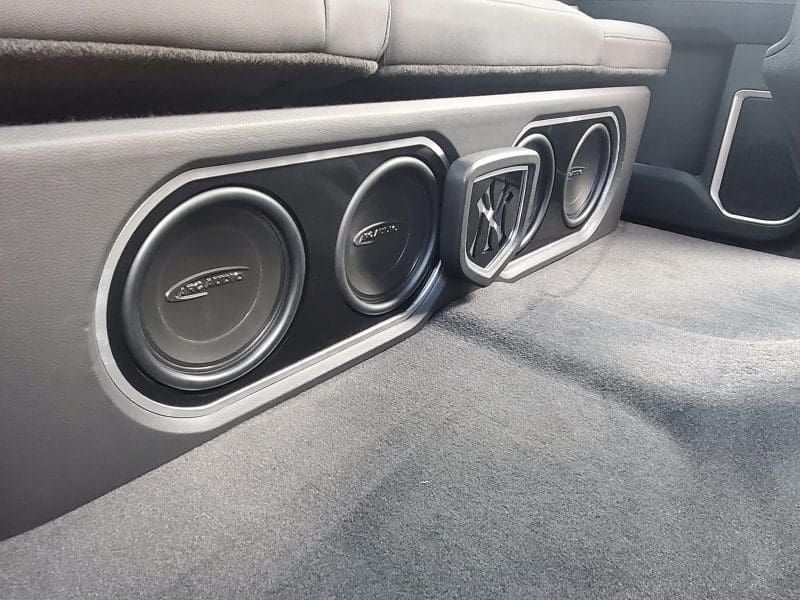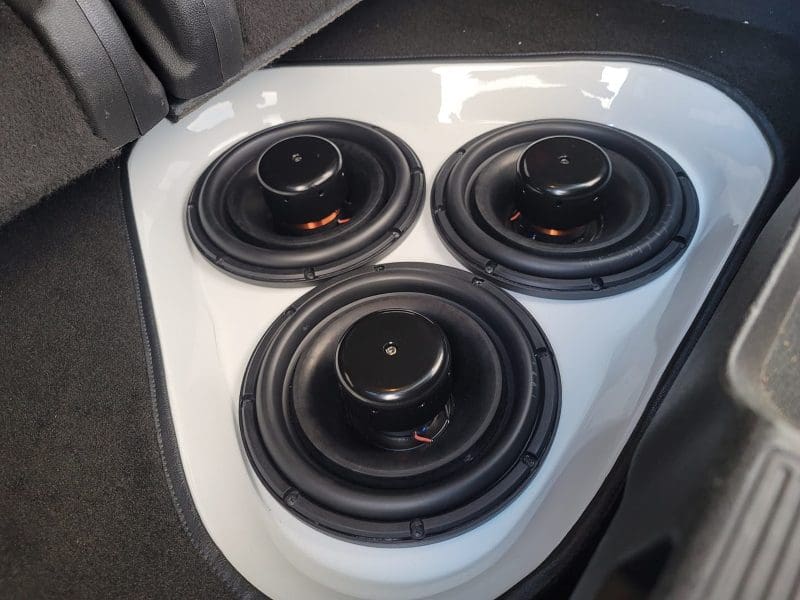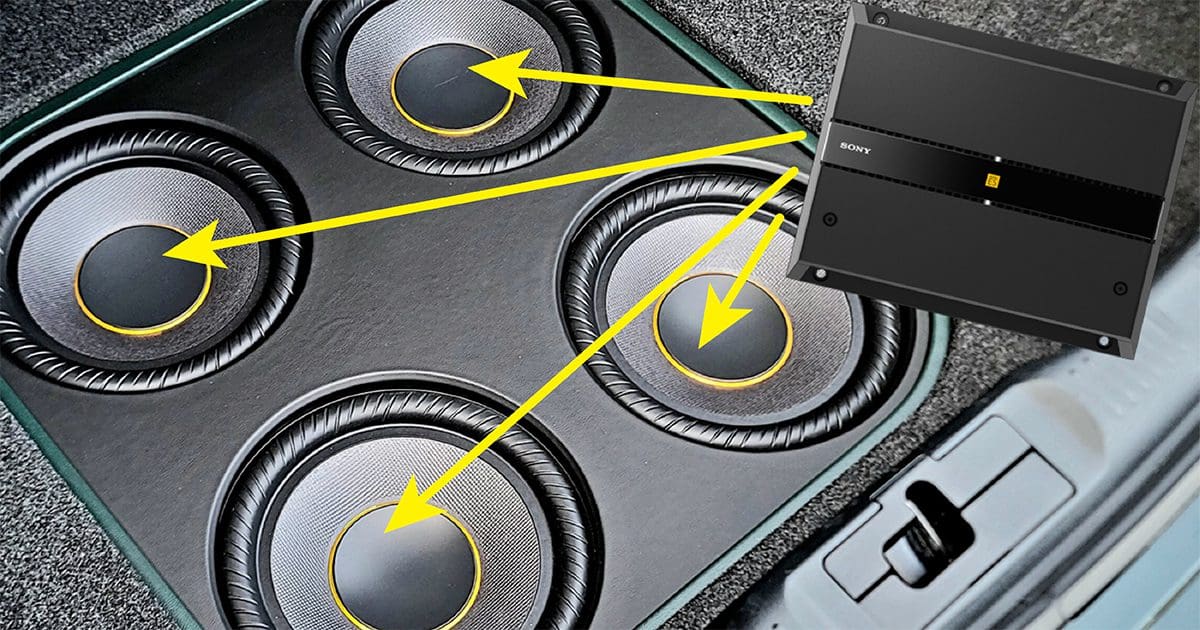We see a lot of questions like “My car audio amp can produce 800 watts; how much power does each of my subs get?” If you aren’t versed in the calculation basics of Ohm’s law, the answer might not be intuitive. Let’s dive into the math and logic that will let us calculate how the power from an amplifier is distributed through multiple speakers or subwoofers.
How Much Power Does an Amplifier Produce?
Without going off about the unimportance of power production versus amplifier quality, we should discuss what determines how much power an amplifier can produce. Most car audio amps use a switching power supply that is designed to chop up and boost the 12 to 14 volts from the battery and alternator, then regulate it to fixed DC voltages that drive the output devices in the amplifier. We refer to these as rail voltages, and they determine the maximum voltage available to the speaker terminals and, ultimately, the speakers or subwoofers.
If we use the example of an amplifier with +30- and -30-volt rails, we have a maximum theoretical voltage of 60 volts that we can apply to the speaker. Ignoring some losses through the output devices themselves, this amp could provide 900 watts into a 4-ohm load. The formula to calculate power given voltage and resistance is P = V^2/R.
Unless the amplifier uses a stiffly regulated power supply design, the rail voltages are typically a fixed multiple of the supply voltage. We’ll ignore some losses and say 30 volts is 2.08 times the supply voltage of 14.4 volts. If the supply voltage drops to 12 volts, our rail voltage would then drop to 25 volts, and we’d only have 50 volts we could use to drive a subwoofer. Our maximum theoretical power is now only 625 watts. This example highlights the importance of ensuring that the most possible voltage is delivered to your amplifier and why you should never skimp on power wiring.
How Amplifier Power Is Divided into Multiple Subwoofers
Our example so far has discussed a single 4-ohm load. What if we have two 8-ohm subwoofers wired together to the amp? How much power can it produce? The answer depends on how the subwoofers are wired. If the subwoofers are wired in parallel to get a net load impedance of 4 ohms, then the amp would produce 900 watts – the same as with a single 4-ohm load. Because both loads are identical, that 900 watts of output is shared evenly between the drivers, with 450 watts going to each.
Now, what happens if we decide to wire the subwoofers in series? An 8-ohm subwoofer wired in series with another 8-ohm subwoofer gives us a net load impedance of 16 ohms. Our amplifier can only produce 156.25 watts into a 16-ohm load. As both subwoofers have the same impedance, the power to each sub is divided evenly, with each receiving 78.125 watts. It’s very unlikely that we would want to run an amplifier at 16 ohms, even though it might be quite efficient.
The amount of power an amplifier produces depends on the maximum unclipped voltage it can produce on the speaker outputs, the impedance of the speakers connected to the amp, and how much current the amplifier can supply to the speakers. Why is current a consideration? What if we connect a 2-ohm subwoofer to our example amplifier? Theoretically, the amp should be able to provide 1,250 watts. In order for this to happen, the amplifier needs to be able to supply 25 amps to the load. That formula is I = P ÷ V, where I is current in amps, P is power in watts and V is voltage. For a well-designed, high-power amplifier, 25 amps isn’t an unreasonable amount of current.
What happens if we connect a 1-ohm load to our amp? The theoretical power jumps to 2,500 watts, and the amplifier would need to be able to supply 50 amps of current to the load. If you’ve looked at amplifier specifications where an amplifier’s power output capabilities don’t roughly double as the load impedance is divided by two, it’s likely because the amp can’t provide the required current into the lower impedances.

Why the Confusion about Amp Power Ratings?
Over the decades, we’ve been taught to think that amplifiers double their power when the load impedance is cut in half. An amp that produces 300 watts into 4 ohms should produce 600 watts into 2 ohms and 1,200 watts into a 1-ohm load. The massive “cheater” amps that were popular in the 1980s and ’90s were often rated similarly to this. However, things have changed significantly.
Let’s look at an example of a modern high-quality subwoofer amplifier like the Rockford Fosgate T500-1bdCP. This amp is rated to produce 300 watts into a 4-ohm load, 500 watts into a 2-ohm load and 500 watts into a 1-ohm load. We can tell from the 4-ohm rating that the amp likely has rail voltages of roughly plus and minus 17.5 volts. Knowing how Rockford Fosgate under-rates their products, the rails are likely running at 19 volts, and that amp would produce roughly 360-ish watts into a 4-ohm load. Nevertheless, let’s stick with the 17.5-volt rails for this discussion. Running a 2-ohm load should then produce just over 600 watts. It’s clear that current delivery into the lower impedance is the limiting factor if the amp is rated for 500 watts. Our math says the amp is limited to about 17.5 amps of current into the speaker load. That’s why the amp doesn’t produce more power into a 1-ohm load.

Current-Limited Amplifier Design Considerations
Why would a manufacturer of high-quality audio products make a design decision to limit how much current one of their amplifiers can produce? The first consideration is heat management. We’ve tested many Rockford Fosgate amplifiers in the past few years. Their high-mass heatsink designs typically allow their amplifiers to run at maximum output continuously for at least 30 minutes if not more.
While 30 minutes doesn’t seem like a long time, for car audio amplifiers, that’s an amazing performance. We’ve seen compact amplifiers from supposedly reputable brands that overheated and shut down in less than three minutes at their maximum undistorted output. Some Brazilian amplifiers we’ve tested shut down in less than two minutes at full power. Reliability is as important as audio quality – you don’t want your music to stop playing because a poorly designed amplifier overheats.
The second reason for the limited-current design is that the output when driving a 4-ohm load is higher. In a classic design that is closer to doubling its power, the amp would only make 125 watts into 4 ohms if it made 500 watts when driving a 1-ohm load. Amp design is much like speaker design in that you have to trade one performance factor for another. As such, it’s not really a “current limited” design; it’s just optimized in a different way than the car audio industry is used to.

Guidelines for Amplifier Power Distribution
Here’s the takeaway in terms of figuring out how much power each subwoofer or speaker connected to an amp will receive. First, determine what your net load will be to the amp. Our article about “Ohms and Loads” can help you with that. Next, look at the amplifier’s published specifications to determine how much power the amp should make. If the specifications aren’t compliant with the CTA-2006-D standard, be wary of their accuracy. Finally, divide the expected power from the amp evenly among the subwoofers connected to the amp.
The above comes with a caveat: All the speakers or subwoofers must have the same impedance. We strongly recommend not mixing and matching drivers with different impedances on the same amplifier channels.
A single 4-ohm subwoofer on our T500-1bdCP would receive 300 watts. A pair of 8-ohm subs wired to a 4-ohm load would result in the amp producing 300 watts, and each driver would get 150 watts of power. If we run a single 2-ohm sub on the amp, it would get 500 watts. If we ran two 4-ohm subs wired in parallel, the amp would produce 500 watts, and each subwoofer would get 250 watts of power. A single 1-ohm sub would get 500 watts. A pair of 2-ohm subwoofers wired in parallel would get 250 watts each. Four 4-ohm subs wired in parallel would result in the amp producing 500 watts, and each sub would get 125 watts.
One last word of advice: Loading your amplifier down to lower impedances in hopes of it making more power will dramatically reduce its efficiency and likely shorten its lifespan.
Upgrade Your Vehicle with a Subwoofer System Today!
We’ll circle back to the beginning of this article to remind everyone that power production has no correlation to audio system quality. You could have a 2,500-watt amplifier, but a better-designed 1,000-watt amplifier might sound better and produce bass that is more accurate.
If you have several subwoofers and want help choosing a great-sounding amp for them, drop by a local specialty mobile enhancement retailer and find out about the solutions they have available. They can explain the options for wiring the subwoofers you have or suggest solutions that will offer amazing performance.
Lead-In image credit: Thanks to Bing from Simplicity in Sound in Milpitas, California, for providing the photo of the four Sony Mobile ES XS-W104ES subwoofers.
This article is written and produced by the team at www.BestCarAudio.com. Reproduction or use of any kind is prohibited without the express written permission of 1sixty8 media.
